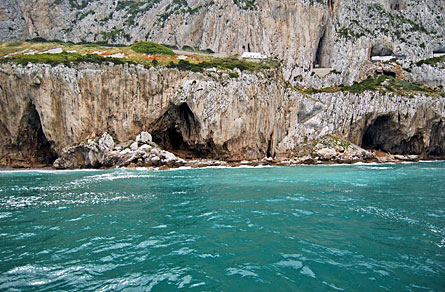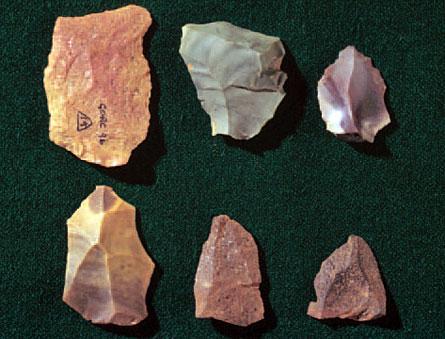Normal 0 false false false MicrosoftInternetExplorer4 Neandertals are often thought of as Ice Age hunters who craved nothing so much as a juicy mammoth steak. But these ancient human cousins favored surf-and-turf when the opportunity arose, a new investigation finds.
In two caves on the eastern side of the Rock of Gibraltar, scientists have unearthed evidence that Mediterranean-dwelling Neandertals ate a varied diet of land and sea animals that put them on a culinary par with Stone Age Homo sapiens, or modern humans.


These finds support the view that Neandertals behaved in ways that have often been attributed only to modern humans, such as regularly visiting seaside haunts to hunt and gather marine animals, according to a team led by anthropologist Christopher Stringer of the Natural History Museum in London. Most Neandertal sites lie in inland parts of Europe and the Middle East, where researchers have traditionally thought the human relatives spent most of their time.
Discoveries in the two caves also play into the hypothesis — first raised by study coauthor Clive Finlayson of the GibraltarMuseum — that Neandertals originally lived in Mediterranean seaside areas and returned there once modern humans entered northern Europe and the Middle East.
Neandertals periodically trekked to southwestern Europe’s Gibraltar caves — now known as Vanguard Cave and Gorham’s Cave — from at least 42,000 years ago until their demise around 28,000 years ago, the researchers report in the Sept. 23 Proceedings of the National Academy of Sciences. From the Gibraltar caves, the northern African coast can be seen across a narrow channel of water.
“That modern human subsistence behaviors would show up among archaic humans like Neandertals, even as late as 28,000 years ago, is startling,” comments anthropologist Pat Shipman of PennsylvaniaStateUniversity in University Park.
The Gibraltar finds indicate that Neandertals engaged in long-range planning and seasonal trips to the coast often attributed only to modern humans, Shipman says.
If behavior did not separate modern humans from Neandertals, it remains unclear why only Neandertals died out, Shipman says.
Survival of various Neandertal and modern human groups in the late Stone Age had a lot to do with being lucky enough to inhabit a livable region as environmental conditions elsewhere deteriorated, in Finlayson’s view.
“Our results show that Neandertals, like modern humans, were opportunists,” Finlayson says. “Dietary differences between places and times reflected what foods were available and had nothing to do with the human species involved.” From his perspective, Neandertals were as smart as Stone Age people.
Anthropologist Mary Stiner of the University of Arizona in Tucson regards the Gibraltar finds as intriguing, especially for their location at the extreme southwestern tip of Europe. In her opinion, though, Stringer’s team has simply confirmed earlier evidence that Neandertals occasionally gathered shellfish and scavenged or hunted sea mammals such as monk seals.
The earliest record of Neandertals’ shoreline activity dates to 110,000 years ago in Italy, Stiner says. Shellfish harvesting by modern humans began in South Africa by around 164,000 years ago (SN: 10/20/07, p. 243).
Too few fossils emerged from the Gibraltar caves to support Finlayson’s contention that Neandertals exploited an array of coastal resources and visited the shore regularly, remarks StanfordUniversity anthropologist Richard Klein.
The presence of a signature type of stone tool identified rock layers in the cave as having been occupied by Neandertals. These layers yielded about 150 mollusk shells and a handful of fossils from seals, dolphins and fish. Other fossils found came from land animals such as red deer, wild boar and wild goats that lived near the coast. Bones from both marine and land animals showed signs of having had meat stripped off by stone implements.
One of the caves also contained a layer from modern human occupation, dating to shortly after the Neandertals’ demise. This layer surrendered a similar range of bones from sea and land creatures.
Based on earlier finds, Klein has hypothesized that after about 50,000 years ago, a behavioral revolution among modern humans led to fishing technology and other cultural advances that Neandertals lacked. Contrary to Finlayson’s argument, modern humans indeed behaved in ways that distinguished them from Neandertals, Klein theorizes.
Stone Age H. sapiens sites in South Africa studied by Klein and others have yielded tens of thousands of mollusk shells and hundreds of seal bones, many bearing incisions made by sharpened stones. Fish bones only become common at these sites after about 50,000 years ago.
Discoveries in the Gibraltar caves add to evidence that no such behavioral revolution ever occurred, Finlayson responds. A substantial number of marine species relative to land species were excavated in both Neandertal and modern human layers, he says. For more than 10,000 years, Neandertals returned to the two caves in order to consume a varied diet that included seals, dolphins and fish.
“For such a small excavation area, these marine-mammal finds are quite remarkable and are no coincidence,” Finlayson asserts.







